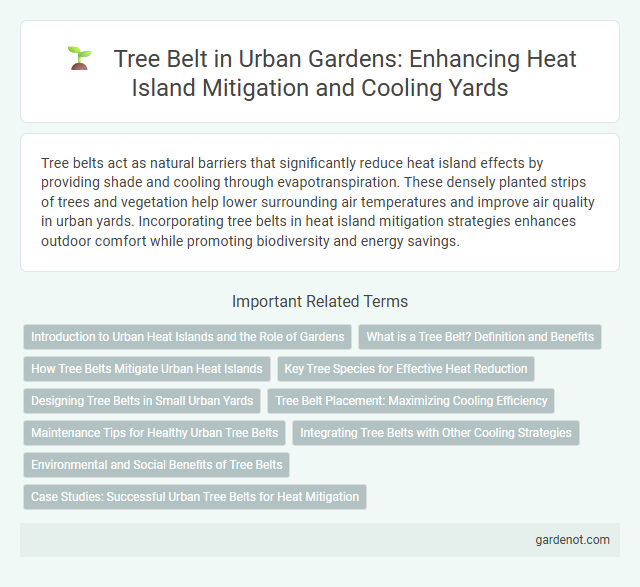Tree belts act as natural barriers that significantly reduce heat island effects by providing shade and cooling through evapotranspiration. These densely planted strips of trees and vegetation help lower surrounding air temperatures and improve air quality in urban yards. Incorporating tree belts in heat island mitigation strategies enhances outdoor comfort while promoting biodiversity and energy savings.
Introduction to Urban Heat Islands and the Role of Gardens
Urban heat islands (UHIs) occur when city areas experience significantly higher temperatures than surrounding rural regions due to human activities and dense infrastructure. Tree belts in gardens serve as effective natural barriers by providing shade, reducing surface temperatures, and enhancing evapotranspiration, which collectively mitigate UHI effects. Incorporating green spaces and tree belts in urban planning significantly improves microclimates and promotes sustainable heat island mitigation.
What is a Tree Belt? Definition and Benefits
A Tree Belt is a strategically planted strip of trees designed to reduce urban heat islands by providing shade and cooling through evapotranspiration. These green corridors improve air quality, lower surface temperatures, and enhance biodiversity within urban environments. Effective tree belts can significantly decrease energy consumption by reducing the need for air conditioning in nearby buildings.
How Tree Belts Mitigate Urban Heat Islands
Tree belts create shaded microclimates by blocking direct sunlight, significantly reducing surface and air temperatures in urban heat islands. The transpiration process from trees releases moisture into the air, enhancing cooling effects and improving local humidity levels. Strategically placed tree belts also act as windbreaks, promoting air circulation that disperses heat and lowers thermal buildup in surrounding areas.
Key Tree Species for Effective Heat Reduction
Key tree species such as oak, maple, and elm offer substantial canopy cover that significantly reduces urban heat islands by providing shade and facilitating evapotranspiration. Native species like sweetgum and sycamore are also effective due to their large leaf area index and high transpiration rates. Incorporating drought-tolerant varieties, such as bald cypress and live oak, ensures resilience while maintaining cooling benefits in diverse yard environments.
Designing Tree Belts in Small Urban Yards
Designing tree belts in small urban yards involves selecting compact, drought-tolerant species that provide maximum shade while fitting limited space. Proper spacing and layering of trees optimize airflow and reduce surface temperatures, effectively mitigating urban heat island effects. Incorporating native plants enhances biodiversity and promotes sustainable microclimates in dense city environments.
Tree Belt Placement: Maximizing Cooling Efficiency
Strategic tree belt placement enhances heat island mitigation by maximizing shade coverage and promoting evapotranspiration, which significantly lowers ambient temperatures. Positioning dense rows of native, drought-resistant trees along southern and western edges of urban yards reduces direct solar radiation on surfaces, improving cooling efficiency. Integrating multi-layered vegetation structures within tree belts further optimizes airflow and microclimate regulation, crucial for sustainable urban heat management.
Maintenance Tips for Healthy Urban Tree Belts
Regular watering and mulching are essential for maintaining healthy urban tree belts, especially during dry seasons to reduce heat island effects. Pruning dead or overgrown branches enhances airflow and sunlight penetration, promoting tree vigor and cooling benefits. Monitoring for pests and diseases early allows for timely treatment, preserving canopy density critical for urban temperature regulation.
Integrating Tree Belts with Other Cooling Strategies
Integrating tree belts with green roofs, reflective pavements, and water features enhances urban heat island mitigation by creating synergistic cooling effects. Tree belts provide shade and evapotranspiration, while green roofs improve insulation and reflective surfaces reduce heat absorption, collectively lowering ambient temperatures. Combining these strategies optimizes microclimate regulation, reduces energy consumption, and promotes sustainable urban environments.
Environmental and Social Benefits of Tree Belts
Tree belts significantly reduce urban heat island effects by providing shade and lowering surface temperatures, improving local microclimates. They enhance air quality through carbon sequestration and particulate filtration, contributing to healthier environments. Socially, tree belts offer recreational spaces, promote mental well-being, and foster community interaction in urban neighborhoods.
Case Studies: Successful Urban Tree Belts for Heat Mitigation
Urban tree belts have demonstrated significant effectiveness in reducing heat island effects by providing continuous canopy cover that lowers ambient temperatures by up to 5degC in case studies such as New York City's Green Streets program and Tokyo's Komazawa Park corridor. These tree belts enhance evapotranspiration and shade, improving microclimates in densely built environments while also boosting air quality and biodiversity. Long-term monitoring data from Singapore's urban tree belt initiatives confirm sustained reductions in surface temperatures and increased thermal comfort for residents.
Tree belt Infographic

 gardenot.com
gardenot.com